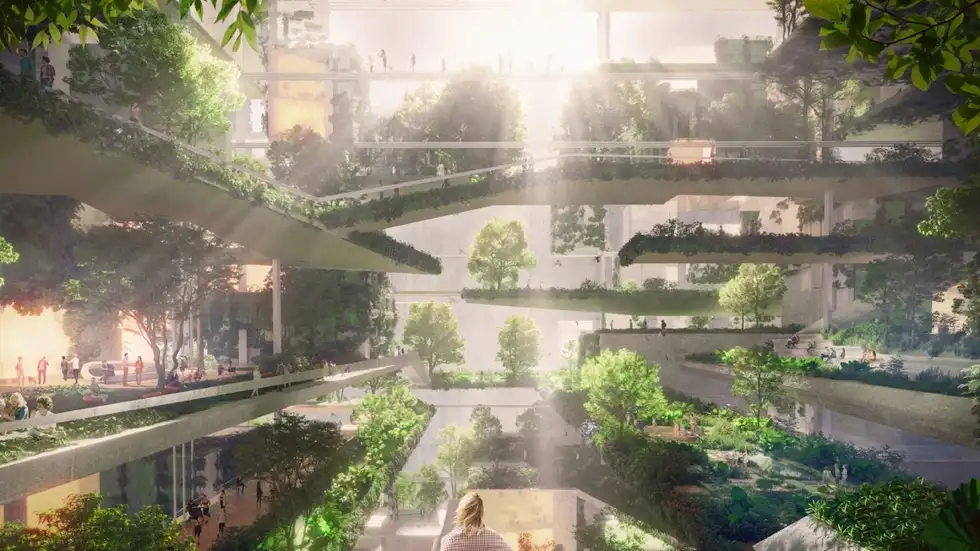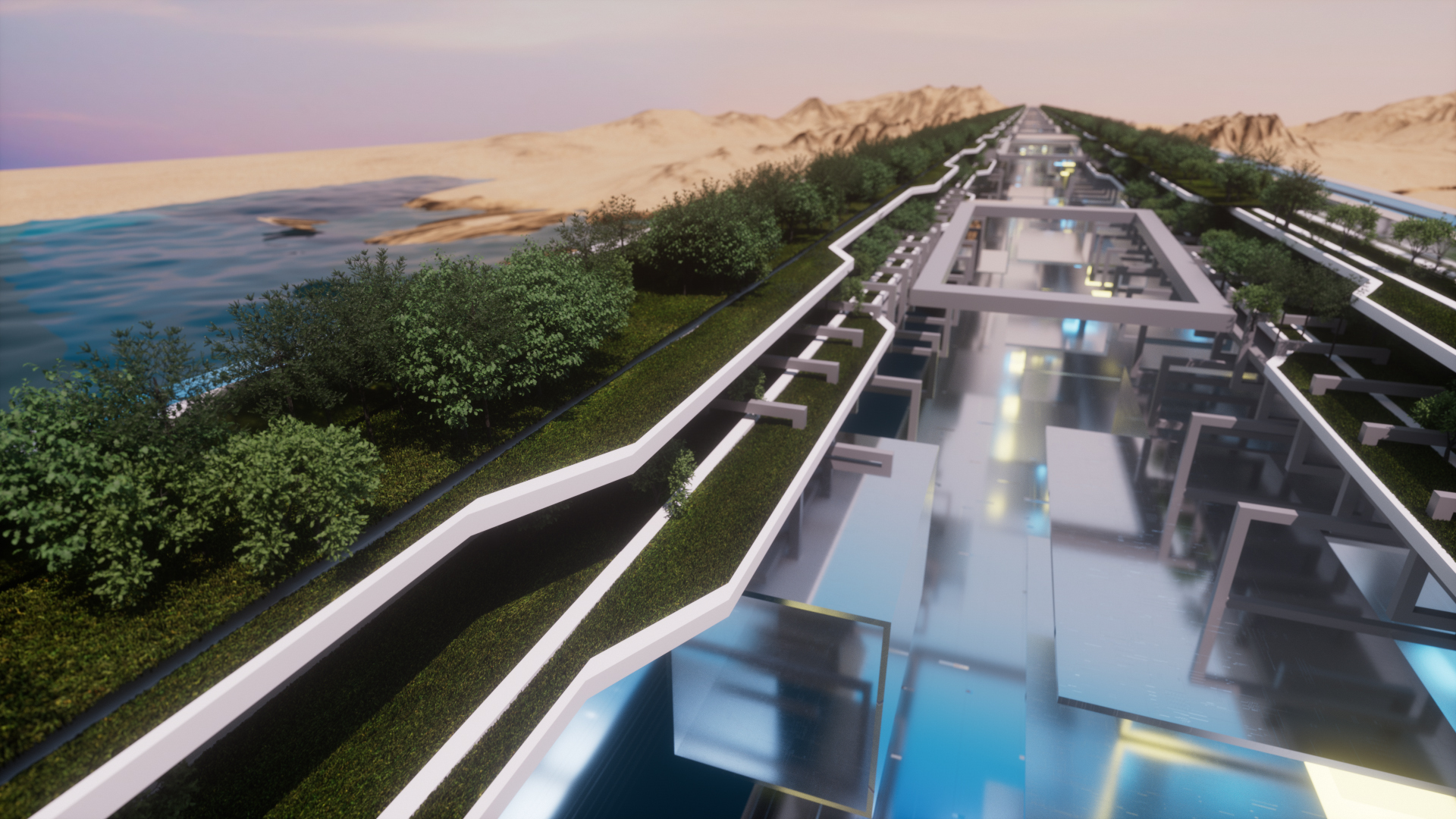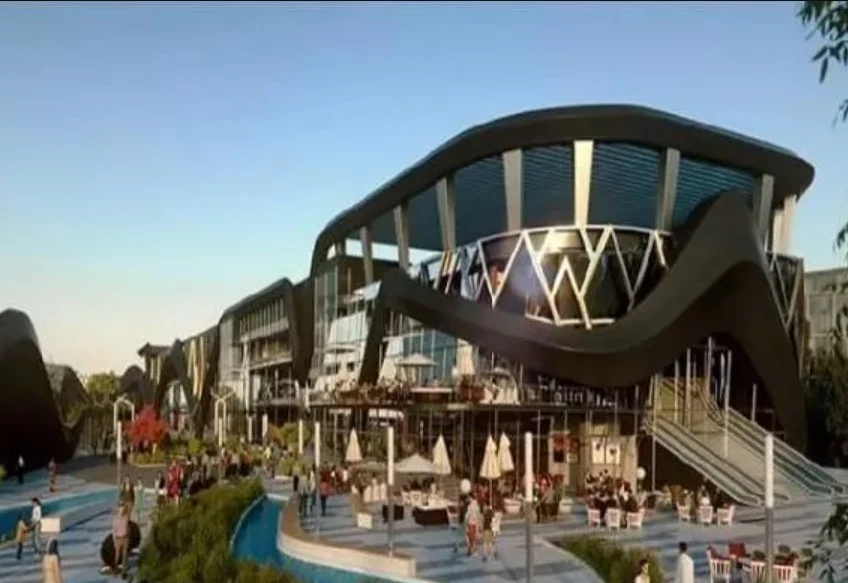Neom, a futuristic city under construction in Saudi Arabia, has been making headlines with its innovative approach to urban living. The centerpiece of this city is “The Line,” a 170-kilometer-long linear smart city that aims to revolutionize urban living. The Line is designed to be car-free, with no streets and zero carbon emissions.
The project is a component of Saudi Arabia’s grand economic diversification and oil dependence reduction plan, Vision 2030. Crown Prince Mohammed bin Salman is the driving force behind this vision, whose main project, Neom, is intended to help transform the country into a hub of innovation and technology.
The Line is not just a city but a bold vision for the future of urban living. It aims to tackle some of the most pressing challenges facing humanity today, such as environmental degradation and the livability crisis in cities. The Line presents a new way of living that blends coziness, sustainability, and ecological harmony with its innovative design and cutting-edge technology.
Concept and Vision
Vision 2030 and Neom’s Role
Neom is a component of Saudi Arabia’s Vision 2030, a calculated plan to lessen the nation’s reliance on oil and diversify its economy. The vision aims to transform the country into a global hub for trade and investment and improve the quality of life for its citizens. The Line, a revolutionary city within Neom, is vital to this vision.
The 170-kilometer-long city known as The Line will be constructed entirely from the start. Ninety-five percent of the land will remain undeveloped for natural purposes, and all power used will be renewable. The city will be free of cars and roads and connected by a network of hyperloops that will transport people and goods at high speeds. Unlike traditional towns, the Line will prioritize people’s health and well-being over transportation and infrastructure.

Crown Prince Mohammed bin Salman’s Ambitions
Crown Prince Mohammed bin Salman, the visionary behind Vision 2030 and the creator of The Line, has big plans for Neom and believes it will be a major force behind innovation and economic growth in the area. The Line is just one of the many ambitious projects the Crown Prince has planned for Neom.
The Crown Prince’s vision for Neom is to create a sustainable, innovative, and technologically advanced city of the future. He wants Neom to be a hub for research and development and a center for new industries. The Line is just the beginning of this vision, and the Crown Prince is committed to making it a reality.
In conclusion, Neom’s Vision 2030 and Crown Prince Mohammed bin Salman’s ambitions are driving the development of The Line, a revolutionary city that prioritizes sustainability, innovation, and human well-being. The Line is a vital part of Neom’s vision to diversify the country’s economy and improve the quality of life for its citizens.
Location and Geography
Neom “The Line” is a 170-kilometer linear smart city currently under construction in Saudi Arabia’s Tabuk Province. It is designed to revolutionize urban living and will run on 100% renewable energy. The city will be built without roads, cars, or carbon emissions.
Red Sea Proximity
The city is situated in the northwest corner of Saudi Arabia, occupying a strategic location that spans over 10,000 square miles (approximately 26,500 square kilometers). The area stretches across the Red Sea coastline, bordering Jordan to the north and Egypt across the Gulf of Aqaba.
Gulf of Aqaba Integration
The city will also integrate with the Gulf of Aqaba, a narrow, 180-kilometer-long body of water separating the Sinai Peninsula from the Arabian Peninsula. Beautiful coral reefs make the Gulf of Snorkeling and scuba diving popular in Aqaba.
The location of Neom “The Line” is ideal for developing a futuristic city, as it provides ample space for growth and expansion. Thanks to the city’s proximity to the Red Sea and the Gulf of Aqaba, residents will also have easy access to some of the most breathtaking natural wonders on earth.
Design and Architecture
Urban Planning Innovations
The Line is a revolutionary urban living project developed in NEOM, Saudi Arabia. It is a 170-kilometer-long linear city that aims to create a new way of living for future generations. The project is designed to be a zero-carbon city focusing on sustainability and green spaces. It is expected to be home to one million people and will be powered entirely by renewable energy.
The urban planning innovations in The Line focus on walkability, with all essential services within a five-minute walk. The city will prioritize public transportation, and cars are prohibited within its borders. The planners envision a city that is pedestrian-friendly, bike-friendly, and accessible to all.
Architecture Studios’ Contributions
Tarek Qaddumi, The Line Design Group’s Executive Director, is leading The Line’s design. He has over 25 years of experience in award-winning architecture firms, including Morphosis Architects, where he served as the regional director. The project is being developed in collaboration with some of the world’s leading architecture studios, including Pei Cobb Freed & Partners and Coop Himmelbauer.
Morphosis Architects created the concept for The Line, a component of the Neom mega project, as their entry into the worldwide design competition. The firm’s design is based on a modular system that can be adapted to different contexts, allowing flexibility and customization. Pei Cobb Freed & Partners is designing the city’s central business district, which includes several skyscrapers. Coop Himmelb(l)au is creating the city’s cultural district, including a performing arts center.
In conclusion, The Line is a groundbreaking project to redefine urban living. Its focus on sustainability, walkability, and public transportation is a model for future cities. The collaboration of some of the world’s leading architecture studios ensures the project will be innovative and visually stunning.
Infrastructure and Mobility
Transportation Networks
The Line project in Neom is designed to be a futuristic city where transportation and infrastructure are prioritized. The project aims to create an innovative, shared, and sustainable public transport infrastructure powered by renewable energy. The transportation network will combine technologies to offer residents an effortless and efficient experience.
The high-speed transportation system within The Line project is a crucial infrastructure that provides fast and efficient connections between different parts of the city. The transportation system will connect other communities and be accessible to all residents. The Line project aims to reduce the reliance on cars and promote the use of public transportation.
Smart City Features
Neom’s Line project aims to build a smart city where residents can use technology to improve their quality of life. The city will use contemporary technology to increase efficiency, livability, and sustainability. The intelligent city features will include a network of sensors and data analytics that will help to manage the city’s resources more efficiently.
The Line project also aims to promote walkability within the city. The project will prioritize the health and well-being of its residents by creating a city that is easy to navigate on foot. The city will have a network of pedestrian walkways, bicycle paths, and green spaces to encourage residents to walk and cycle more.
In conclusion, The Line project in Neom aims to create a futuristic city prioritizing infrastructure and mobility. The project aims to create an innovative, shared, and sustainable public transport infrastructure powered by renewable energy. The city will also be equipped with advanced technologies to make it more efficient, sustainable, and livable. The project will promote walkability and reduce the reliance on cars, making it a more sustainable and healthy city for its residents.
Sustainability Initiatives
Renewable Energy Implementation
Neom is committed to sustainable development and is implementing various renewable energy initiatives to reduce its carbon footprint. The city of the future is designed to run on 100% renewable energy, and it is expected to be one of the most sustainable cities in the world.
One of the major renewable energy projects in Neom is constructing a 1.2 GW wind farm. The wind farm will have 150 turbines and generate enough electricity to power over 400,000 homes. In addition to the wind farm, Neom is also constructing a 300 MW solar farm, one of the world’s largest.
Green Hydrogen Projects
Neom is also investing in green hydrogen projects to reduce its dependence on fossil fuels. Green hydrogen is created by splitting water into hydrogen and oxygen, utilizing wind and solar energy to generate electricity. The hydrogen can then be used as a clean fuel to generate electricity and drive vehicles.
Neom is planning to build a 650-ton-per-day green hydrogen plant. The plant will be one of the world’s largest and produce green hydrogen using renewable energy sources. Neom’s trucks, buses, and other vehicles will run on the plant’s green hydrogen.
Neom’s commitment to sustainability and renewable energy is commendable, and it is expected to set a new standard for sustainable development worldwide.
Economic and Social Aspects
Public Investment Fund Role
Attempting to wean the economy off of oil, Saudi Arabia’s Vision 2030 includes the Neom initiative. The Public Investment Fund (PIF), the primary investment vehicle of the Saudi Arabian government, is financing the project. The PIF has committed $500 billion to the project, which is expected to create significant economic opportunities for the country.
Job Opportunities and Urban Life
One of the main objectives of the Neom project is to create job opportunities for Saudi nationals. The project will create around 380,000 direct and indirect jobs by 2030. In addition, the project will build a brand-new urban setting intended to improve inhabitants’ quality of life. The Line, a vital component of the Neom project, is a 170-kilometer-long city designed to be wholly car-free and powered by renewable energy.
The Line will also feature a range of amenities and services, including schools, hospitals, shops, and entertainment facilities. The city will be designed to be walkable, with green spaces and public areas that encourage social interaction. The aim is to create a livable and sustainable urban environment that promotes health, well-being, and community.
In conclusion, the Neom project is a significant investment in Saudi Arabia’s future. It is expected to create substantial economic and job opportunities for Saudi nationals. The Line, which is a critical component of the project, is designed to create a new urban environment that is sustainable, livable, and promotes community. The Public Investment Fund funds the project and is vital to Saudi Arabia’s Vision 2030.
Environmental Considerations
Nature Preservation Efforts
The Line project in Neom aims to preserve the region’s natural beauty by maintaining 95% of the land for nature. Only 5% of the land will be used for urban development. The project also includes the creation of a nature reserve, which will be home to various flora and fauna.
The project team has taken steps to minimize the project’s environmental impact to ensure that the natural environment is not disturbed. For example, the project will use 100% renewable energy and will not have any roads or cars, which will help reduce pollution and the environmental impact of transportation.
Sustainable Urbanism Principles
The Line project in Neom is designed to follow sustainable urbanism principles. This means the project will prioritize walkability, clean energy, and technology to avoid traffic, pollution, and other infrastructure challenges plaguing urban life.
To meet this objective, the project team has planned for the city to run entirely on clean energy. The city will also be car-free, which will help reduce pollution and the environmental impact of transportation. The project team has also ensured the town is walkable, with pedestrian-friendly streets and public spaces.
The Line project in Neom is a promising example of sustainable urbanism. By prioritizing nature preservation and sustainable urbanism principles, the project aims to create a city that is both environmentally responsible and livable for its residents.
Cultural and Recreational Facilities
Trojena Ski Resort
Offering an outstanding skiing experience, Trojena Ski Resort in Neom is a first-rate establishment. The resort has a range of amenities, including eateries, retail stores, and ski lifts. With more than 20 runs, the slopes are enjoyable for skiers of all ability levels. Ski lessons are available at the resort for both beginner and experienced skiers. Open all year round, Trojena Ski Resort provides a range of winter activities, such as snowboarding and skiing.
Hidden Marina and Sindalah Offerings
At Sindalah Offerings and Neom’s Hidden Marina, guests can partake in various leisure pursuits. The marina offers numerous water sports, including sailing, kayaking, and fishing. To see the breathtaking coastline, tourists can also take a boat tour of the region. Sindalah, on the other hand, offers a range of activities on land, including hiking, mountain biking, and horseback riding. The area is also home to wildlife, including gazelles and Arabian Oryx.
The Hidden Marina and Sindalah Offerings are also home to various amenities, including restaurants, cafes, and shops. Visitors can savor a meal or a drink while enjoying the area’s stunning views. The area also has various cultural attractions, including museums and art galleries. While admiring the breathtaking surroundings, tourists can discover the region’s history and culture.
Neom’s Cultural and Recreational Facilities offer various activities and amenities. Whether visitors want to hit the slopes, explore the coastline, or learn about the area’s culture and history, Neom has something to offer.
Challenges and Criticisms
Human Rights Concerns
Neom “The Line” project has been criticized for its potential human rights violations. The project is led by Crown Prince Mohammed bin Salman, who has been accused of being involved in the murder of journalist Jamal Khashoggi. The project has also raised concerns about the displacement of the Howeitat tribe, who live in the area where the project is being built. The tribe has already been displaced once before, and there are fears that they will be forcibly removed from their land again.
Economic Feasibility and skepticism
The Neom project is ambitious and expensive, estimated at $500 billion. Some experts have expressed skepticism about its economic Feasibility, as it is unclear how it will generate enough revenue to cover its costs. The project also needs help attracting investors, as many are wary of investing in a project led by a government with a poor human rights record. There are also concerns about the project’s environmental impact, as it involves building a city in the middle of the desert.
Despite these challenges and criticisms, the Neom project continues to move forward. The Saudi government remains committed to the project and has already invested billions of dollars in its development. The project is anticipated to accelerate regional economic growth and generate thousands of new jobs. However, it remains to be seen whether the project will successfully achieve its ambitious goals or face further challenges and setbacks in the years to come.

Frequently Asked Questions
What is the projected completion date for The Line in Saudi Arabia?
The completion date for The Line in Saudi Arabia has yet to be officially announced. However, the NEOM website states that the city and the entire NEOM project will be completed in 2030.
What are the latest updates on the construction progress of The Line?
As of Q1 2024, the world’s largest piling operation is underway, with over 2 million m³ of earth moved weekly. According to the NEOM website, 260 excavators and 2,000 trucks work 24/7 to ensure the project is completed on time.
How much is the estimated cost for the development of The Line?
The estimated cost for developing The Line has yet to be publicly disclosed. However, the NEOM project as a whole is estimated to cost around $500 billion.
What is the length of the Line being developed in NEOM?
The Line city being developed in NEOM is approximately 170 kilometers long.
Have any significant milestones been reached in the NEOM project?
Yes, significant milestones have been reached in the NEOM project. In 2021, the Saudi government announced the completion of the first phase, which included the construction of the airport and the establishment of the legal and regulatory framework for the city.
What technological innovations are being integrated into The Line?
The Line is being designed as a fully automated city without cars or roads. Instead, residents will travel using high-speed public transportation systems, such as trains and autonomous vehicles. The city will also run on 100% renewable energy and incorporate advanced technologies such as artificial intelligence, robotics, and biotechnology.
KSA MLS
Empower your real estate journey in Saudi Arabia with KSA MLS. Effortlessly connect with a network of active brokerages and eager clients throughout the kingdom’s dynamic market. Access a diverse range of properties, unlock new avenues of opportunity, and achieve remarkable success.












